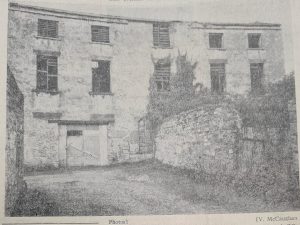Oldest Celbridge House Is Coming Down (Leinster Leader, 1967)

OLDEST CELBRIDGE HOUSE IS COMING DOWN
The Leinster Leader November 18 1967 – Lena Boylan

The oldest house in Celbridge is soon to be demolished by Kildare County Council.
For over two and a half centuries it has been a landmark in the town’s history. It is an unsightly building and can only claim the sentiment of some of Celbridge’s older residents whose fathers and grandfathers received their education there in the middle of the 19th century when it was known as Mr. Kelly’s Academy. The local volunteers who drilled there during the War of Independence could scarcely be aware of its academic connections. It was then a disused shed and derisively called “The Shelbourne,” a name which some local wit decided it merited when it became the lodging house of many families towards the close of the 19th cent. Students and writers of the Georgian period in Ireland seldom overlook the Rev. Samuel Shepherd. His poetic works are often quoted. Some of his best lines were written while he lived in this house when he was Vicar of Celbridge and Straffan from 1735 until his death in 1785. He was also chaplain to the Earl of Chesterfield and the Duke of Dorset during their terms as Lords Lieutenant of Ireland.
The Rev. Shepherd tried to introduce some semblance of stone building. Traces of fine plasterwork in the ground floor still bear evidence of his efforts. In those rooms he and his wife, Kitty, daughter of the distinguished Dublin attorney, Simon Anyon, entertained their guests with sirloins and claret. However, the house, according to its occupier, still remained sickly. For so he described it to his sister-in-law.
“The house (an emblem of your own condition)
Not desp’rate quite – yet calls for a physician:
Within all pleasant, tho’ without all drooping;
Joy fills the parlour, while the roof is stooping.”
Previous to the Rev. Shepherd’s occupation, the house with 54 acres was known as Scott’s holding. It was granted to Robert Scott by Col. Thomas Dongan. Earl of Limerick, in 1709 and was part of the Earl’s Castletown estate. The house was then a two-storeyed building and regarded as one of the finest in the town, as it was built of stone, the other houses for the most part being mud cabins.
With the house at the time of the Rev. Shepherd’s purchase there remained only sixteen of the original fifty-four acres.
In 1719 James Willis, to whom Catherine Scott granted her late husband’s property by a deed of assignment in 1712, leased 35 acres to Robert Baillie, who annexed them to Kildrought House which he built around this time. Those 35 acres were in the fields and parks called Ryan’s Park, The Long Park, The Little Park and Sclifford’s Park. To-day they are part of the lands of Beatty Park House.
After the Rev. Shepherd’s death his family let the house and sixteen acres, and removed to Leixlip.
They eventually sold the property in 1812 to Michael Dignam, a builder and timber merchant from Bridgefoot St. Dublin. He was son of Laughlin Dignam who in local phraseology would be termed “an old neighbour,” the family having resided in the town from the time of the Earl of Limerick. Michael Dignam and his brother, Matt, built the three houses that now front the Rev. Shepherd’s courtyard.
The Dignams were the last family to occupy the house, and from them Mr. Kelly rented the rooms in which he held his Academy.
The new thoroughfare, as planned by the Co. Council, will cut through the foundation of the centuries old building; it will also carve up the Rev. Shepherd’s courtyard and orchard, but for the people in the new housing scheme it will reduce the distance to the village by one mile.
Re-Typed by Darragh Holland.
